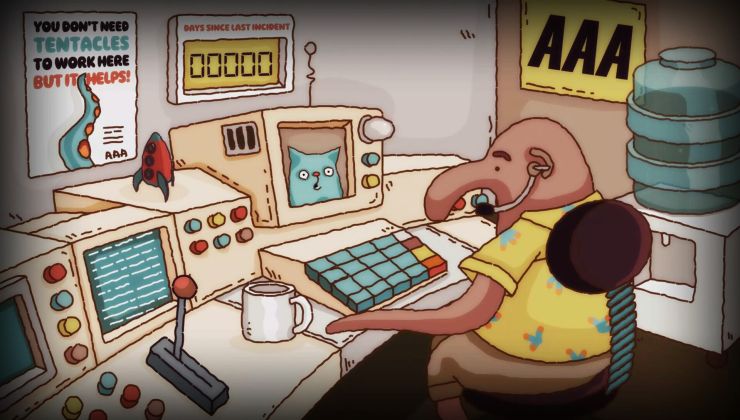As they promised they would, AMD has now officially published the source code for FidelityFX Super Resolution 2 (FSR 2) under an open source license. With it under the MIT license, developers can pretty much go nuts with it.
This tech is their newer and more advanced temporal upscaling solution, supporting the Vulkan and DirectX 12 graphics APIs, it's fully supported on Linux and works on different vendor GPUs (not just AMDs). AMD say it "uses cutting-edge temporal algorithms to reconstruct fine geometric and texture detail, producing anti-aliased output from aliased input". Developed from the ground-up, it's quite a big difference from FSR 1 to provide even better performance and clearer images. Developers can even use both since they're so different.
FSR 2 features include:
Temporal
- Delivers similar or better than native image quality using temporal data.
Anti-aliasing
- Includes high-quality anti-aliasing.
- FSR 2 replaces any TAA within the game frame.
High image quality
- Higher image quality than FSR 1 technology at all quality presets/resolutions.
- Different quality modes available.
- Dynamic Resolution Scaling supported.
No machine learning
- Does not require dedicated Machine Learning (ML) hardware.
- More platforms can benefit.
- Gives more control to cater to a range of different scenarios.
- Better ability to optimize.
Cross-platform
- Boosts framerates in supported games.
- Wide range of products and platforms, both AMD and select competitors.
You can see a number of their comparisons on their GPUOpen website.
Fingers crossed this is worked into existing games retroactively too, although that might be too much to hope for.
Replacing TAA sounds a bit worrying though. As I understood from a tech discussion by Star Citizen devs (in response to making TAA optional), TAA often includes more than just anti-aliasing and can be very hard to separate from other rendering features. If so, that may hinder adoption.
I'm wondering about the "anti-aliasing" bit. This is what I've always been interested in. Can you render at normal resolution and just use it as a form of anti-aliasing. Would the results be good?
Replacing TAA sounds a bit worrying though. As I understood from a tech discussion by Star Citizen devs (in response to making TAA optional), TAA often includes more than just anti-aliasing and can be very hard to separate from other rendering features. If so, that may hinder adoption.
Well, DLSS replaces TAA, so I don't think it would be too much of a stretch to think that FSR2 could replace it. I actually prefer the way DLSS looks compared to TAA.
My understanding of this is limited, but I think it has to be engineered into the game - FSR2 can't be "hacked" into a game externally the way we had with FSR1. But from the videos I've watched, it's pretty incredible. I couldn't really tell the difference between FSR1 and DLSS, but now you'd need a zoomed in side-by-side comparison to spot the difference.
Fingers crossed this is worked into existing games retroactively too, although that might be too much to hope for.
My understanding is that it works without the need for a game to support it. Additionally, it would work regardless of whether one is using an AMD or Nvidia GPU. This is kinda FSR's big selling point over DLSS. DLSS needs to be built into the games and is limited to Nvidia GPUs, where FSR is neither.
My understanding of this is limited, but I think it has to be engineered into the game - FSR2 can't be "hacked" into a game externally the way we had with FSR1. But from the videos I've watched, it's pretty incredible. I couldn't really tell the difference between FSR1 and DLSS, but now you'd need a zoomed in side-by-side comparison to spot the difference.
Fingers crossed this is worked into existing games retroactively too, although that might be too much to hope for.
My understanding is that it works without the need for a game to support it. Additionally, it would work regardless of whether one is using an AMD or Nvidia GPU. This is kinda FSR's big selling point over DLSS. DLSS needs to be built into the games and is limited to Nvidia GPUs, where FSR is neither.
FSR2 needs to be implemented per game just like DLSS. RSR which is based on FSR1 can be used regardless of an implementation. However the downside of this is that the whole game is affected and this includes the Ui and the gamemenus as well. So things can become quiet tiny and text is hard to read in some games.
My understanding of this is limited, but I think it has to be engineered into the game - FSR2 can't be "hacked" into a game externally the way we had with FSR1. But from the videos I've watched, it's pretty incredible. I couldn't really tell the difference between FSR1 and DLSS, but now you'd need a zoomed in side-by-side comparison to spot the difference.
Fingers crossed this is worked into existing games retroactively too, although that might be too much to hope for.
My understanding is that it works without the need for a game to support it. Additionally, it would work regardless of whether one is using an AMD or Nvidia GPU. This is kinda FSR's big selling point over DLSS. DLSS needs to be built into the games and is limited to Nvidia GPUs, where FSR is neither.
FSR2 needs to be implemented per game just like DLSS. RSR which is based on FSR1 can be used regardless of an implementation. However the downside of this is that the whole game is affected and this includes the Ui and the gamemenus as well. So things can become quiet tiny and text is hard to read in some games.
Fair enough. However, is FSR2 still GPU agnostic?
My understanding of this is limited, but I think it has to be engineered into the game - FSR2 can't be "hacked" into a game externally the way we had with FSR1. But from the videos I've watched, it's pretty incredible. I couldn't really tell the difference between FSR1 and DLSS, but now you'd need a zoomed in side-by-side comparison to spot the difference.
Fingers crossed this is worked into existing games retroactively too, although that might be too much to hope for.
My understanding is that it works without the need for a game to support it. Additionally, it would work regardless of whether one is using an AMD or Nvidia GPU. This is kinda FSR's big selling point over DLSS. DLSS needs to be built into the games and is limited to Nvidia GPUs, where FSR is neither.
FSR2 needs to be implemented per game just like DLSS. RSR which is based on FSR1 can be used regardless of an implementation. However the downside of this is that the whole game is affected and this includes the Ui and the gamemenus as well. So things can become quiet tiny and text is hard to read in some games.
Fair enough. However, is FSR2 still GPU agnostic?
Nvidia Geforce 1000 series and newer are supported besides the AMD GPU'S.










 How to set, change and reset your SteamOS / Steam Deck desktop sudo password
How to set, change and reset your SteamOS / Steam Deck desktop sudo password How to set up Decky Loader on Steam Deck / SteamOS for easy plugins
How to set up Decky Loader on Steam Deck / SteamOS for easy plugins
See more from me